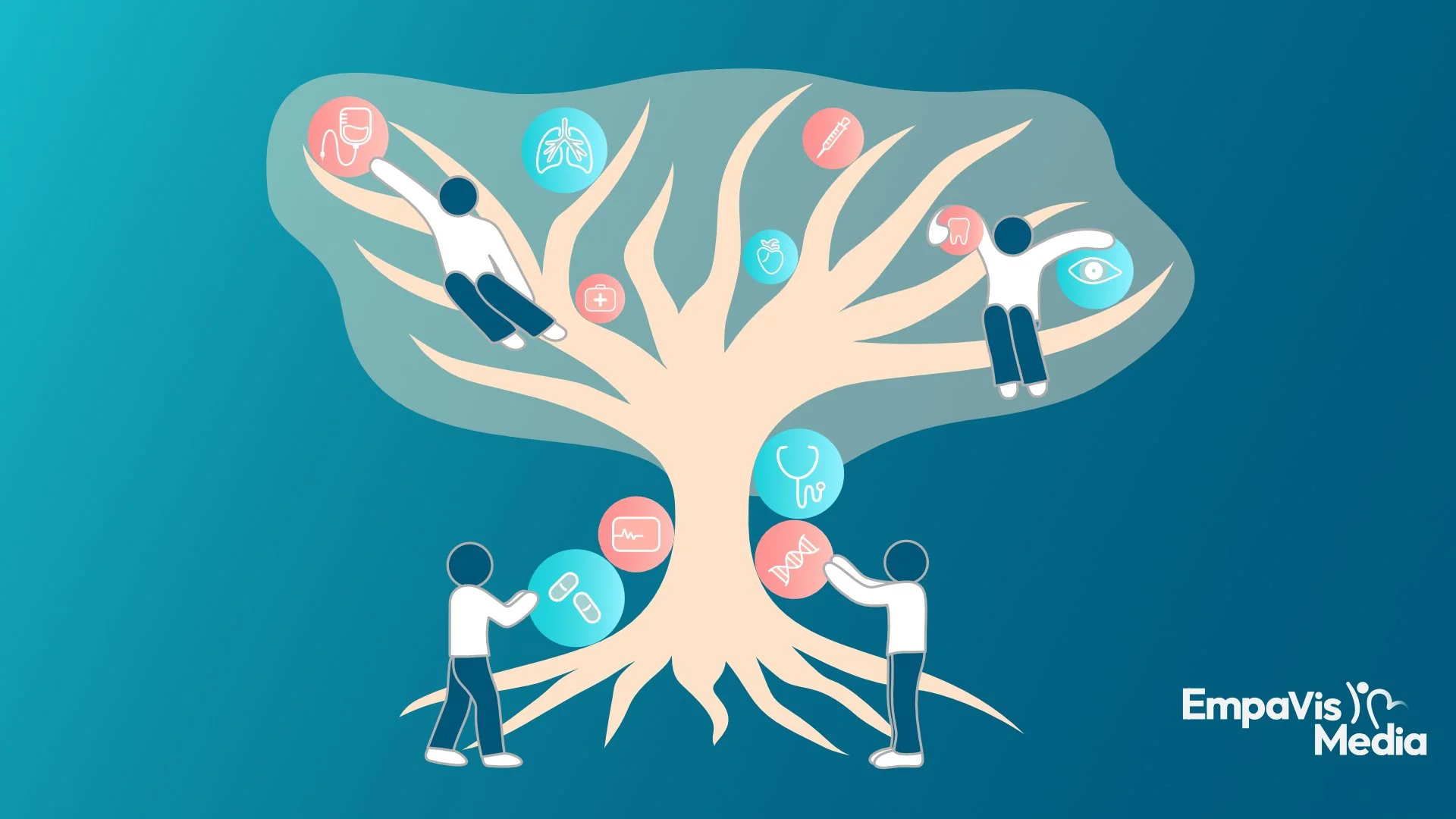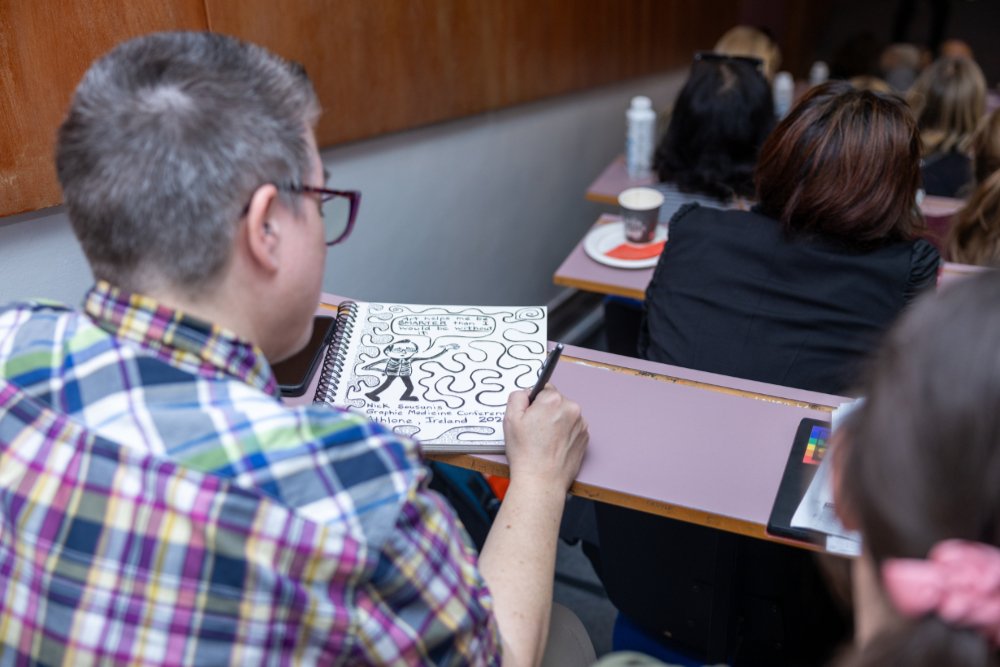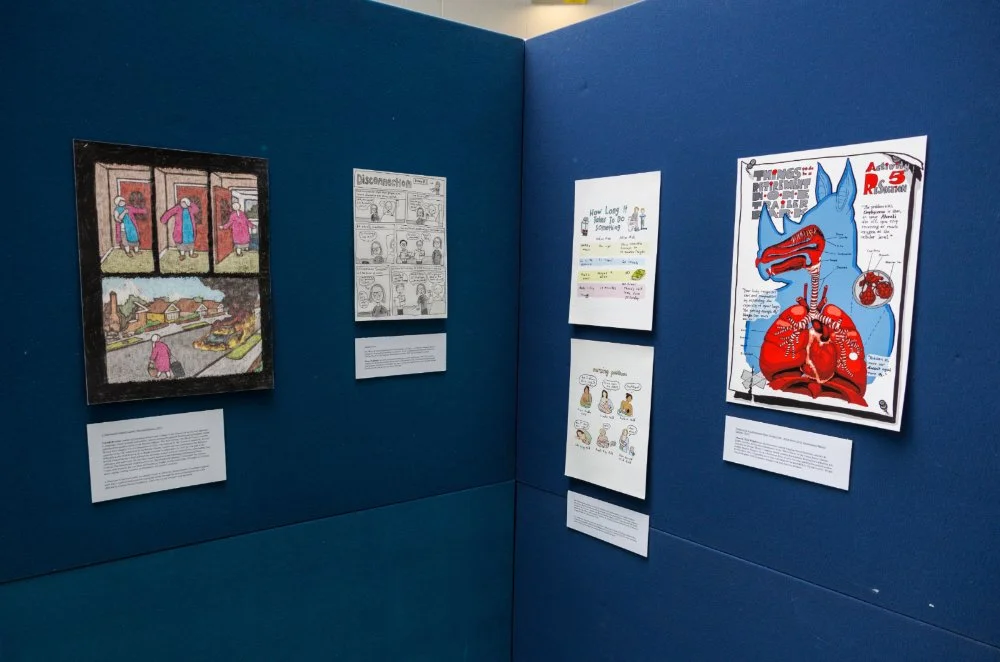Demystifying Medicine: How Creative Media Makes Healthcare Accessible
(Note: This blog post was originally published by our Creative Director, Michaela Murphy on 15 October 2024 on LinkedIn)
I was pleasantly surprised a few years ago to find myself having watched a whole Science series in a day. It was BBC’s ‘Wonders of the Universe’ (1) presented by astrophysicist Dr. Brian Cox. I knew I had embraced the topics of the show when I was laughing at a meme about entropy weeks later (2). It sparked a renewed interest in Science for me. I followed blogs and websites with fun science facts. Why is it that school couldn’t teach it like that? After years of trying my best and feeling like the world of Science just wasn’t for me, I felt I was becoming part of the club. How did the TV series achieve this? Straight away you need to consider the impressive computer-generated visuals that recreate the explosion of a supernova, or the cameras that sweep through the stars of a galaxy. They are cinematic, engaging, colourful, and perfectly illustrate Dr. Cox’s descriptions. Then you have the way he explains processes and the laws of physics through experiments carried out with everyday items in everyday places. The Science is taken out of the lab and brought to the viewer on their terms. Imagine if healthcare, a field that regularly affects all of us, was given similar treatment.
How many of us have gone to a doctor and quietly taken the prescription away without asking what the medication was or what it did to help us? Maybe we felt that truly understanding the medication was out of our reach. Maybe we thought it was too complicated or even that it’s just the doctor’s job to know these things. It’s likely that at some point we have picked up our medication, half-remembered verbal instructions from the pharmacist, thrown away the unappealing leaflet and taken the pill at the wrong time of day. Upon knowing that a seemingly insignificant decision could actually do some harm, we should consider that small problems in communication can cause big problems for someone’s health.
Medicine can be intimidating and hard to understand for those not experienced in it. In many cases, while medical teams can equip patients with the tools to help them recover, actually carrying out the treatment, like taking a pill or monitoring one’s blood sugar levels, is done by the patient themselves at home (3). Therefore, it is important to consider the patient most when conveying information about medical products. With this approach, the patient can be prepared, relaxed, and better able to comply with their treatment. (4)
The use of creative media and technology can increase a sense of empowerment for the public. Not only can they better understand their health, but they can be encouraged to engage in preventative attitudes and behaviours. They become familiar with any required treatment quickly and are more likely to ask questions. Through an area of medtech known as ‘connected health’, teams are developing ways to create better opportunities for clinicians to communicate with patients and encourage them to self-manage their treatments. (5) Connected health technology such as wearables or implanted devices (6), are developed to work seamlessly with smartphones and internet connections, which are already widely available. Such technology can collect real-time patient data and use it to help diagnose patients and review treatment plans. (5)
Augmented Reality
As part of connected health, augmented reality can help to establish familiarity with a medical product. Augmented Reality (AR) is a form of immersive media that integrates digital media, such as 3D models, images, sound, or text into a real-world view by overlaying the content over what you can see through a phone’s camera. AR, while more commonly associated with video games and eCommerce, holds great potential in the area of healthcare (7). It is widely used to educate medical students on anatomy, and it aids surgeons during procedures (8) by overlaying inner anatomy and data such as radiographic images on the patient’s body. It is not just healthcare professionals and educators that should be seen as the users of this technology, as its potential in the home and public space is growing. As described by Krishna Saini in his blog, AR could be used by members of the public to take action in cases of emergency, where artificial intelligence guides the user through the steps required in resuscitating a person in cardiac arrest. (7) Philips have embraced this vision with a concept for the future, where the user wears smart glasses to see real-time graphical instructions on and around the patient’s body (9).
Philip's Scan Buddy App
Philips has also used augmented reality and immersive visual media to reduce anxiety in young patients before and during MRI scanning. In relation to scanning procedures, a webinar held by Philips Healthcare outlined that 91% of patients experience anxiety beforehand. This anxiety is likely to result in the patient moving during the scan, making the resulting images inaccurate and requiring repeat scanning. This in turn raises costs for hospitals. It is especially difficult for children under 8 years old to stay still during a scanning procedure, and they may need sedation or general anaesthetic for a scan to be accurate. Anaesthetic carries delays and risks. (4) Philips Healthcare therefore released an initiative aimed at preparing a child for the scan, making them familiar with the scanning machine and environment.
The Scan Buddy App can be explored at home in the child’s own time. In this app, an animated animal guides the child through mini-games, such as identifying metal objects and explaining why they aren’t allowed in the scanner. The child helps prepare the animal character for a scan, attaching any extra scanning accessories needed. One such accessory covers the head, which would undoubtedly be frightening to the child without preparation. The augmented reality element of the app asks the child to find a clear area on the floor, onto which a 3D model of the MRI scanner can be seen. The child is encouraged to walk around it and engage in a sticker hunt that unlocks additional fun content. The app even shows the child what being in the machine looks like from a first-person perspective to let them experience the view they will see on the day. (10)
All stages of the process: the app, a small physical model of the scanner, and the media within the MRI scanner itself are consistent in the use of the animated characters, colours, voices, and 3D models. This ensures that the child recognises all they have seen before the scan. There are clear benefits to making educational media immersive and this applies to sound too. The Scan Buddy App’s media works to desensitise children to the sounds that an MRI machine makes by including them in a fun game. (4) The app contains informational pages for the parent or guardian that informs them about the scan on a deeper level and assists them in how to use the app alongside the child (10). This promotes trust and confidence in the parent. It was found that approaches in educating and engaging young patients reduced their anxiety and resulted in a drop of patients being sedated from 57% to just 5% (4).
SUPERHUMAN Exhibition
CÚRAM, Research Ireland Centre for Medical Devices, part of the University of Galway, has led the curation of an exhibition ‘SUPERHUMAN’ in the Galway City Museum, which showcases the evolution of medtech research in the Galway region and across Ireland (11). Backed by Galway City Council, the exhibition is designed by Mirador Media and built by Triangle Productions Ltd. It encourages visitors of all ages to interact with installations that focus on a particular body part, such as the brain, eye, and heart. All this ties into teaching the visitors about CÚRAM’s research on Parkinson’s Disease, Stroke, and Diabetes. (13)
Alongside the exhibits, the visitors can watch films of real-life patients discussing their conditions and treatments. While making the young people of Galway more comfortable with medical technology, the exhibition promotes preventative care (12) and is paving the way for a new generation of engineers and inventive thinkers in healthcare. The exhibition's creators achieve this by adding a sense of fun to the visit. Information in an exhibit is accompanied by QR codes, with which visitors are encouraged to download educational packs with games that are associated with a certain part of the body. Fun facts are placed around the walls and can be ‘discovered’ by flipping their covers. The visitor learns how far the spectrum of medical devices go from everyday objects to food.
Sensory learning is encouraged by making exhibits interactive and tactile. One part of the exhibition encourages you to touch materials used in the making of medical devices. Another uses light projections to overlay images of the inner layers of the human arm onto your real arm. Before the images appear, the lights simulate a scanning function. Even as an adult visitor, this was impressive and fun to play with, and helped me to visualise simple parts of my body in a new way. Other exhibits, such as the ‘eye’ area, use colours of our anatomy to their best advantage, encouraging visitors to explore as much of the exhibit as they can. The anatomy portrayed is aesthetically striking and in no way gruesome or inappropriate for children. The visualisations and models are as realistic as they need to be to understand the anatomy, while being fun to engage with.
The exhibition highlights Galway as an important medical device hub in Europe, offering fun facts on the how many products are manufactured and exported from the region (13). Younger generations can be inspired to pursue Science in their education and embrace what their location can offer their future careers. This exhibition also has great potential in normalising the use of medical devices in a person’s everyday life, giving confidence to younger people with medical conditions that may cause embarrassment or discomfort. This will in turn foster empathy from those not familiar with those conditions.
Image of ‘Your Spare Parts’ exhibit taken while visiting SUPERHUMAN exhibition in 2024. Exhibition curated by CÚRAM Science Foundation Ireland (SFI) Research Centre at Galway City Museum.
Graphic Medicine
I recently came across this article by Gail Conway that covered a conference held at TUS in Athlone in July. The event was the 15th International Graphic Medicine Conference, a global event previously held in other countries. During this conference, healthcare professionals and educators were encouraged to create comics, allowing them to explore the emotions they have in working with difficult health conditions, and to express empathy with patients.
‘Graphic Medicine’ is an area of creative media where medical information and research topics are told as a narrative through comic books, graphic novels, or posters. The pieces do not need to be created by professional designers. Anyone with a story to tell about their condition is encouraged by this movement to express it through art. ‘Graphic Medicine’ is a term that Dr. Ian Williams of http://graphicmedicine.org started using in 2007 and there are dedicated courses teaching the discipline across Europe and North America. (14)
Comics give the creators a platform to discuss uncomfortable topics such as death, drug addiction, and cancer, and allow them to make the portrayals of their experiences honest. It is a therapeutic process and offers a window into topics that any reader can empathise with (15), also aided by the use of simple illustration and text elements (14). This is another creative medium in which complex medical conditions are conveyed in a clear and concise way and has potential to improve patient and clinical education across all ages.
The National Library of Medicine showcases graphic medicine publications on their website that explore experiences around subjects such as mental illness and eating disorders, while also showcasing work by healthcare workers based on their experiences in the field (16). What struck me in viewing these pieces was the unflinching and sometimes humorous honesty that jumps out of the page. As much as my own lack of personal experience of those conditions allowed, I could begin to understand what the authors were going through.
Attendee taking part in Graphic Medicine workshop. Image of the Graphic Medicine International Collective Conference 2024, taken by Nathan Cafolla and Jeff Harvey, courtesy of Technological University of the Shannon (TUS).
Completed Graphic Medicine pieces being displayed. Image of the Graphic Medicine International Collective Conference 2024, taken by Nathan Cafolla and Jeff Harvey, courtesy of Technological University of the Shannon (TUS).
Growth in Public Understanding
Our health is important for us to understand, be comfortable with, and feel confident about. Medical devices and treatments give us a level of control over our health that we may not realise or appreciate that we have. We shouldn’t feel intimidated by treatments and devices that go through years of design, iteration, and regulatory approval. A treatment that has been so well designed as to make our quality of life better deserves to be easily understood. We have seen developments in patient understanding with the use of apps and immersive media. There is accessible learning in the public space about chronic conditions in a fun exhibition, and there is potential for fostering empathy from a wide audience through comics. The benefits of creative media are wide-reaching across healthcare, ensuring that it is clear, embraced, and complied with. While the healthcare and creative industries do not seem closely related, the synergy between the two cannot be ignored. When put together, they help to build bridges between experts, patients, and the public.
BBC, “Brian Cox explains why time travels in one direction - BBC”, YouTube, March 10, 2011, 0:00 to 5:32, https://www.youtube.com/watch?v=uQSoaiubuA0
ChemCruz (@ChemCruz_Chems), “Entropy! Image credit: HMP comics”, Twitter, June 27, 2016, 6:19PM, https://x.com/ChemCruz_Chems/status/747479371347197952
HSE. “Self-Management Support”. HSE.ie. 2024. https://www.hse.ie/eng/about/who/healthwellbeing/selfmanagement/
Philips Healthcare, “Philips MR Patient Experience | Prepare and guide children for their MRI scan”, YouTube, January 4, 2023, 00:00 - 24:20, https://www.youtube.com/watch?v=qzWSEkTGdOg
Insight. “Connected Health”. Insight-Centre.org. no date. https://www.insight-centre.org/connected-health/
KORE. “Connected Health: What It Is and How It Works“. korewireless.com. 2024. https://www.korewireless.com/news/connected-health-what-it-is-and-how-it-works
Saini, Krishna. “Augmented Reality (AR): Revolutionizing Healthcare Beyond Video Games”. LinkedIn (blog). August 3, 2023, https://www.linkedin.com/pulse/augmented-reality-ar-revolutionizing-healthcare-beyond-krishna-saini
Pieterse, Arianne D., Beerend P. Hierck, Peter GM de Jong, Jelger Kroese, Luuk NA Willems, and Marlies EJ Reinders. "Design and implementation of “AugMedicine: lung cases,” an augmented reality application for the medical curriculum on the presentation of dyspnea." Frontiers in Virtual Reality 1 (2020): https://doi.org/10.3389/frvir.2020.577534
Philips, “How AR is revolutionizing healthcare – and how it could one day save your life”, YouTube, November 8, 2022, 01:28 – 04:11, https://www.youtube.com/watch?v=z3owLTiEGJ4
Philips. “Philips Scan Buddy App. A playful guide for an MRI exam“. Philips.ie. 2024. http://www.philips.com/scanbuddyapp
Galway City Museum. “SUPERHUMAN“. galwaycitymuseum.ie. 2024. https://galwaycitymuseum.ie/exhibition/superhuman/
Mirador Media. “Superhuman at Galway City Museum“. miradormedia.ie. 2024. https://www.miradormedia.ie/project_superhuman.html
SUPERHUMAN. Galway City Museum. Galway, September 26, 2023 - Present. Exhibition.
Conway, Gail. “Ties between comics and medicine explored in Co Westmeath“. RTE.ie. July 17, 2024, https://www.rte.ie/news/leinster/2024/0717/1460272-graphic-medicine/
Graphic Medicine. “Graphic Medicine“. 2024. https://www.graphicmedicine.org/
National Library of Medicine. “Explore”. NIH.gov. no date. https://www.nlm.nih.gov/exhibition/graphicmedicine/collection.html




